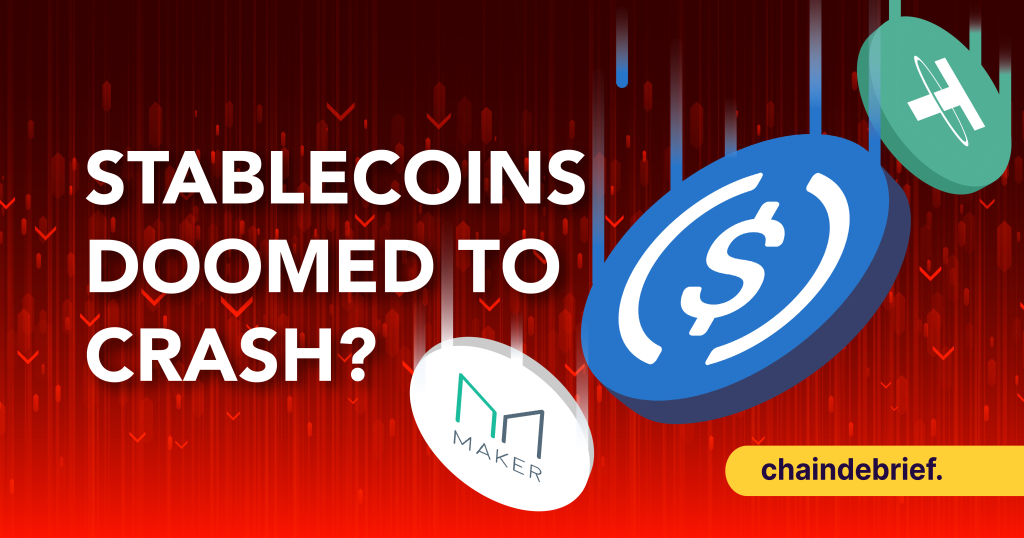A very unfortunate event happened over the past week, UST depegged from the dollar and it sent LUNA straight to the grave. Many people around me lost their savings overnight. If you are one of them, do not hesitate to reach out to us. Our DMs are always open.
If you lose any significant amount of money, it's okay. Money can be made back, but not your health and wellbeing.
— Chain Debrief (@ChainDebrief) May 11, 2022
Reach out to anyone if you need help. Our DMs are open too.
This incident raised a very important question: are stablecoins really stable? But before we dive into that, we first need to answer the question, what are stablecoins?
What are stablecoins?

As cryptocurrencies don’t require an intermediary institution for payment transactions, they can be used by anyone anywhere in the world.
However, unlike the government-issued fiat money such as U.S. Dollars, or gold, cryptocurrencies come with the drawback that prices can fluctuate frequently and drastically, making them challenging for everyday use.
For instance, bitcoin can be priced at $30,000 today and goes up to $33,000 tomorrow, a 10% change in just 1 day.
Stablecoins try to tackle price fluctuations by tying the value of cryptocurrencies to other more stable assets – usually fiat currencies.
Being supported by assets outside the cryptocurrency landscape, the prices of stablecoins are typically “stable” hence the term, therefore reducing potential financial risk.
Stablecoins that are backed by fiat currencies for example the US Dollars, basically encounter the same risk as the backing asset.
They offer fast transactions, privacy and security of cryptocurrency payments while also ensuring volatility-free stability, especially for risk-averse investors.
Not all stablecoins are equal
Stablecoins can be classified according to the different types of assets backing them, mainly – fiat currency, commodity, crypto assets, and seigniorage or non-collateralized stablecoins.
This reflection of the various types of stablecoins offers insight into the stability of the stablecoin price. As volatility is reduced with the stability provided by stablecoins, once shaky market participants might now find it easier to enter the cryptocurrency market.
1. Fiat-backed stablecoins

Various currencies, for example, the U.S. Dollar or the Chinese Yuan, are used as collateral to back stablecoins. This is the most commonly accessed backing. Stablecoins are pegged to a 1:1 ratio of the fiat currency.
For example, an equivalent sum of cold hard cash, backing the same amount of digital stablecoins, is stored securely in a “reserve” such as a physical bank. The money serving as collateral can be withdrawn from the reserve to cash out tokens as a form of exchange.
An example of a fiat-backed stablecoin is Tether (USDT). It is the first stablecoin in the market. Fiat-backed stablecoins offer the most stability. The value of 1 USDT will be the same as the value of 1 US Dollars, and you can use USDT to buy any cryptocurrency.
2. Cryptocurrency-backed stablecoins

Another way of pegging stablecoins to assets is through the use of other cryptocurrencies, for example, Ether, instead of a fiat currency. Cryptocurrency-backed stablecoins are decentralised without a single person or entity in control of the funds.
It is the most complex form of stablecoins as the backing is usually through multiple cryptocurrencies to better distribute potential risk. One example of such a stablecoin is the popular DAI by MakerDAO, which is pegged against the U.S. Dollar and has a basket of crypto assets acting as the reserve.
3. Commodity-backed stablecoins
This includes the use of hard assets such as precious metals, like gold (most commonly used) and silver, real estate, or oil. Stability is provided as the stablecoins are tied to the value of these precious metals.
4 Non-collateralised stablecoins

This process doesn’t involve the use of reserves or assets and instead takes place through an algorithm by implementing a smart contract in an independent manner.
Coins are created or destroyed by the algorithm to match the value of their target price. For example, if the target price drops, coins would be burned to increase the stablecoin’s price, similar to how banks would print notes to maintain price valuation for fiat currencies.
Will the other stables crash like UST?
If you don’t know what happened to UST, you can read our summary here: What Happened To $LUNA? How It Crashed More Than 95% From Its All-Time High
Fortunately, many of the big stablecoins in the market are fundamentally different from UST. The current top three stablecoins are all cash-backed and are still holding the peg even in a volatile market.
Let’s take the USDT as an example. USDT is classified as a fiat-backed stablecoin and it is backed by a range of assets including commercial paper and unsecured debt. It does not rely on an algorithm to keep its value pegged to the dollar.
Tether, the company behind USDT, announced that they are reducing commercial paper in their holding and increasing the number of US treasury bills (a more secure and liquid asset).
Tether Continues to Honour All Redemptions from Verified Customers During Market Volatility, On Track To Process 2bn Today https://t.co/p1AugHb9Gn
— Tether (@Tether_to) May 12, 2022
The FUD and panic about USDT happened again and it fell to as low as US$0.95. It slowly climbs back up and it is now back to the dollar peg. Tether honoured all USDT redemption and it is estimated that Tether processed more than US$3 billion worth of USDT redemption.
Regulators from all over the world are looking into UST meltdown and it would only be a matter of time before they come out with a legal framework for cryptocurrencies.
While many in the crypto space are unhappy about regulations as they restrict creativity, I on the other hand think that regulations that help to safeguard retail investor interest would help drive global adoption.
We are still early!
[Editor’s Note: This article does not represent financial advice. Please do your own research before investing.]
Featured Image Credit: Chain Debrief
Also Read: Make Or Break Your Bank: Here Are 5 Things You Need To Know About Tokenomics



































